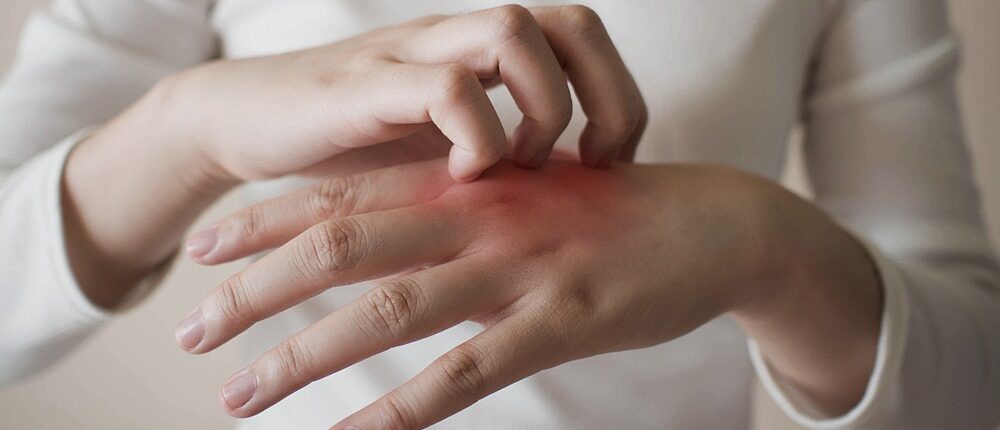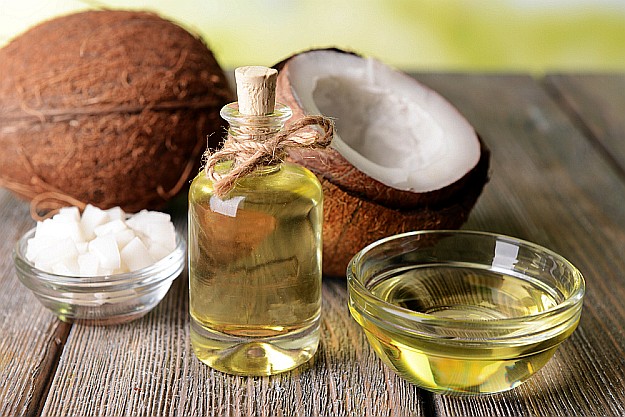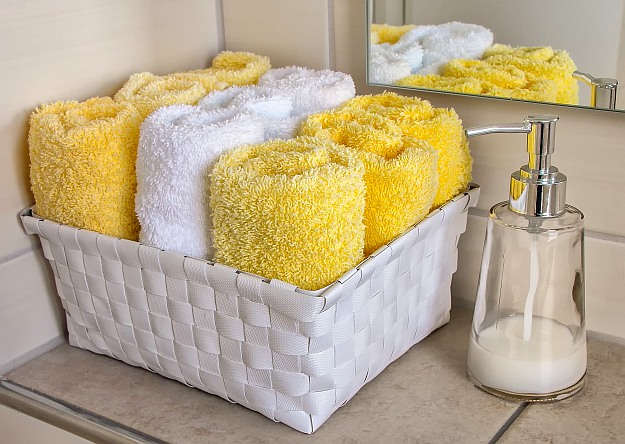

Until you develop hand eczema, it’s impossible to understand just how uncomfortable the condition can be. Whether you have dyshidrotic eczema, atopic dermatitis, contact dermatitis, or another type of eczema, your priority is probably the same. You want to stop that raw, dry feeling, along with the redness, blisters, cracks, and scaling. If you’re trying to avoid aggressive treatment, natural remedies can come to the rescue.
What You Need To Understand About Hand Eczema
In this article:
Understanding Eczema
There are several types of eczema, including contact dermatitis, atopic dermatitis, and dyshidrotic eczema. The various eczema types tend to have overlapping symptoms—and it’s even possible to have more than one type at a time. Most forms cause redness and itching. They can also involve blisters and cracked, flaking skin.
If you have dyshidrotic eczema on your hands, you’ll probably notice them more at the edges of your fingers and palms. Hay fever and exposure to certain metals, such as nickel in rings and bracelets, can cause dyshidrotic eczema on your hands. Some people also get this type of eczema after prolonged exposure to wet conditions.
Atopic dermatitis eczema often appears on the backs of your hands. Atopic dermatitis is a form of chronic hand eczema. This condition often accompanies other types of allergies, like asthma and hay fever.
You’re at a higher risk of experiencing atopic dermatitis if there’s a family history of this class of allergies.
Your hand problems might also be a case of contact dermatitis, in which your hand reacted to something it touched. Chemicals in clothing and body care products, certain plants, and animal dander can all provoke this type of allergic reaction. You might notice a rash and weeping blisters, along with a burning sensation.
Does it matter what kind of eczema you have? It may, because you can learn to avoid factors which cause flare-ups. But some people can develop more than one kind of eczema. Because the symptoms overlap, nailing down the exact eczema form may be less of a priority to you in relation to your immediate need to control the pain and discomfort of blisters, redness, itching, burning, flaking, and general dryness.
Hand Eczema Treatments
For many people, it is possible to control those symptoms without prescription help. Many natural eczema treatments will soothe your condition, whichever specific eczema it may be. And even if your doctor does suggest steroid or antibiotic intervention, these natural remedies can provide relief until the more aggressive treatment takes effect.
Plant-Based Oils

Coconut oil has natural, antibacterial qualities. This natural ingredient also boasts deeply-moisturizing properties to help address the cause as well as the symptoms of your hand dermatitis. It is semi-solid in cool weather, and liquid in warm weather. Take a small amount and massage it into your hands. If your skin absorbs it quickly, add more.
Sunflower seed oil also delivers a one-two punch to eczema. It’s an anti-inflammatory, so redness and itching can be soothed. In addition, the consistency of sunflower seed oil provides a layer of protection that’s superior to other oils. That protective barrier traps much-needed moisture into skin tissue, preventing evaporation. To make the most of sunflower seed oil’s barrier protection abilities, rub it into your hands just after washing them, while your hands are slightly damp. The moisture will be better retained this way.
Amaranth oil is another useful plant-based oil to use, especially in combination with another oil or “butter,” such as shea butter. Amaranth oil is useful for skin cell repair. It is also anti-inflammatory, which makes it high in the fatty acids and vitamins that help people resist allergies and skin condition.
Apply one of these natural oils or butters to your hands at least twice a day. If your hand dermatitis is primarily on the backs of your hands, the less messy way to apply it is to put a dab the oil on the back of one hand, then rub the backs of both hands together. Consider alternating which type of oil you use throughout the day, because coconut, amaranth and sunflower seed oils each have distinct healing qualities. Together, they can soothe hand eczema symptoms on several fronts.
One thing to keep in mind: If you know you’re allergic to either coconuts or sunflower seeds, avoid the oils made from them. Most people who have a bad reaction to eating certain foods will also be allergic to external applications of products made from those foods.
Herbal Compresses
If you’re not already familiar with common wild plants, this is a good time to learn to recognize them. Two of the most common, chickweed and plantain, can be soothing for people with eczema. Plantain is a broad-leaved, weed which has spiky brown flowers in the center. The leaves have vertical veins.
Chickweed is low-growing and deceptively delicate looking. The tiny leaves and flowers, however, can be trampled upon and gathered without harming it.
Process chickweed and/or plantain leaves in a blender, with a bit of sunflower seed, amaranth or melted coconut oil. The oil will help bind the herbal paste together while imparting its own healing qualities.
Smear the herbal paste over the affected part of your hand, and hold it in place with gauze. Leave this compress in place for at least 30 minutes, and put a fresh compress on later in the day. Both plants are not only soothing for itching, burning, and flaking, but they also draw out pus and other impurities from blisters. That’s why changing the gauze at least once a day is important.
Don’t want to mess around with weeds and homemade pastes? Try cold compresses dipped in herbal tea instead. Chamomile is especially soothing, but lavender tea is another healing concoction. Brew a strong pot of one or both teas, and add it to a basin of cool water. Once the entire basin of water is cool, dip a clean washcloth in it. Wring the washcloth out, and apply it to your skin. Change these cold compresses as often as you can.
Elimination Diet
For many patients, eczema sometimes stems from—or is worsened by—specific foods. Often, an eczema flare-up just after specific meals will make it obvious which foods to avoid. But food-related skin allergies are not always easy to diagnose. One thing you can try is removing certain groups of foods from your diet.
Consider going dairy-free for one week to determine if any improvement occurs. The same can be true of foods containing gluten, including breads, pastas, and cereals. Fortunately, today’s consumers can find a wealth of dairy and gluten alternatives that replace the milk, cheese, and grain products you rely on.
If your food allergy or sensitivity isn’t immediately obvious, you can try cutting your diet down to a few essentials, then begin adding foods gradually. If your hands or other body parts begin showing signs of eczema, you’ll know that the most recently-added foods are the ones you’ll need to remove from your eating plan permanently.
Healing Hand Soaks
A basin that’s large enough to soak both of your hands, along with water and a bit of oatmeal or baking soda—these are often all you need to provide relief for itching, burning hand eczema. Baking soda and oatmeal each provide relief for itching and redness. Buy colloidal (finely ground) oatmeal at a drugstore, or make your own by powdering it in a blender. Add about one cup of baking soda or powdered oatmeal to about two gallons of very warm water. Stir the mixture, then soak your hands for at least ten minutes. Pat your hands bone-dry immediately after your hand soak. Alternatively, dry your hands slightly, then add a moisturizing lotion or oil.
Clean, Dry Towels

It might not seem like much of a magic formula, but keeping your hands dry is a must when you have hand dermatitis. Stock plenty of hand towels around your house so that you’re never tempted to let damp be “good enough.” (The exception to this, of course, is if you’re going to be applying a moisturizing lotion or oil.
In that case, slightly moist hands are preferable because the skin care product will help trap the moisture.) Make sure the towels are also clean. When you have cracks and sores, bacteria can make its way in through dirty towels.
Relief Is Possible!
Along with the pain and discomfort of hand eczema, many people are embarrassed because the problem can’t be hidden away under most conditions. Seeing a dermatologist may be helpful for aggressive forms of chronic hand eczema. That’s especially true with severe symptoms. You may need topical steroids, or even oral antibiotics to fight related infections.
Learn more about hand eczema and how to treat it naturally with this video from Natural Eczema Treatment:
Often, however, home treatments can soothe the pain, itching and other symptoms of hand dermatitis. Find a natural product that works for you or make your own from natural ingredients. These simple methods can help you get a good night’s sleep and ease the stress caused by eczema. In turn, becoming more rested and relaxed will decrease the severity of future flare-ups.
Have you tried these natural treatments to manage your hand eczema at home? Share your tips in the comments section below.
Up Next: Examination of Eczema Creams
